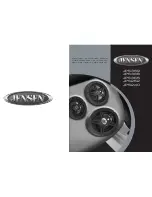
CONTROL_1_5_V_3_0.DOC
21/25
Make sure that the amplifier is disconnected from the mains before you set the operation-mode-switch to
parallel.
Bridge the red pole sockets of Output Channel 1 and Output Channel 2.
Connect your speakers to the Speaker-socket Output CH-1.
Caution!
Before switching on your amplifier, please refer to the explanations under Operation.
Adjust the level with the gain-control CH-1 on the frontpanel.
Bridging
Possibility to run the amplifier in mono-mode, i.e. via one input channel. In bridged operation mode, the
current remains the same, the voltage is doubled. Consequently, the output impedance is doubled.
For stereo-operation, 2 amplifiers are needed.
Connect the input signal to the input-plug CH-1 on the rearpanel.
Make sure that the amplifier is disconnected from the mains before you set the operation-mode-switch on the
frontpanel to Bridge.
Connect your speakers to the red Speaker-socket Mono Bridged.
Caution!
Before switching on your amplifier, please refer to the explanations under Operation.
Adjust the level with the gain-control CH-1 on the frontpanel.
Choosing appropriate connection cables
The speaker-system must only be connected via a sufficiently dimensioned cable. Too thin cables lead to
cable heatup or enormous power loss and loss in sound-quality.
For all speaker-systems up to 400 Watts, we recommend a cable diameter of 2.5 mm², for all other speaker-
cables 4 mm².
A high damping factor of your amplifier supplies a clear sound reproduction. Unnecessarily long and thin
cables will influence the damping factor and thus the low frequencies in a negative way. In order to
safeguard good sound quality, the damping factor should lie around 50. The longer a cable has to be, the
thicker it should be.
In this respect, a damping factor of 200 will be reduced to 47 (8 Ohms) when using a 10 m long, 2.5 mm²
speaker cable. The power loss at 8 Ohms is 1.63 %, at 4 Ohms 3.25 % and at 2 Ohms even 6.5 %.
The maximum cable length is 30 meters!
Connections
Your speaker-system can be connected via the 2-pole terminal on the rear panel.
Attention:
Consider the polarity of the speakers when installing your system. "Positive" and "negative"
terminals on the amplifier must be connected to the corresponding "positive" and "negative" terminals on the
speakers.
1. Connect one end of your speaker wire to the negative right terminal on your amplifier. Connect the other
end of your speaker wire to the negative input terminal of the right speaker.
2. Connect one end of your speaker wire to the positive right terminal on your amplifier. Connect the other
end of your speaker wire to the positive input terminal of the right speaker.
3. Connect one end of your speaker wire to the negative left terminal on your amplifier. Connect the other
end of your speaker wire to the negative input terminal of the left speaker.
4. Connect one end of your speaker wire to the positive left terminal on your amplifier. Connect the other end
of your speaker wire to the positive input terminal of the left speaker.
INSTALLATION
This speaker-system must only be installed at a solid, plane, anti-slip, vibration-free, oscilation-free and fire-
resistant location.
Before installing the system, make sure that the installation area can hold a minimum point load of 5 times
the system's load (e.g. weight 20 kg - point load 100 kg).





































